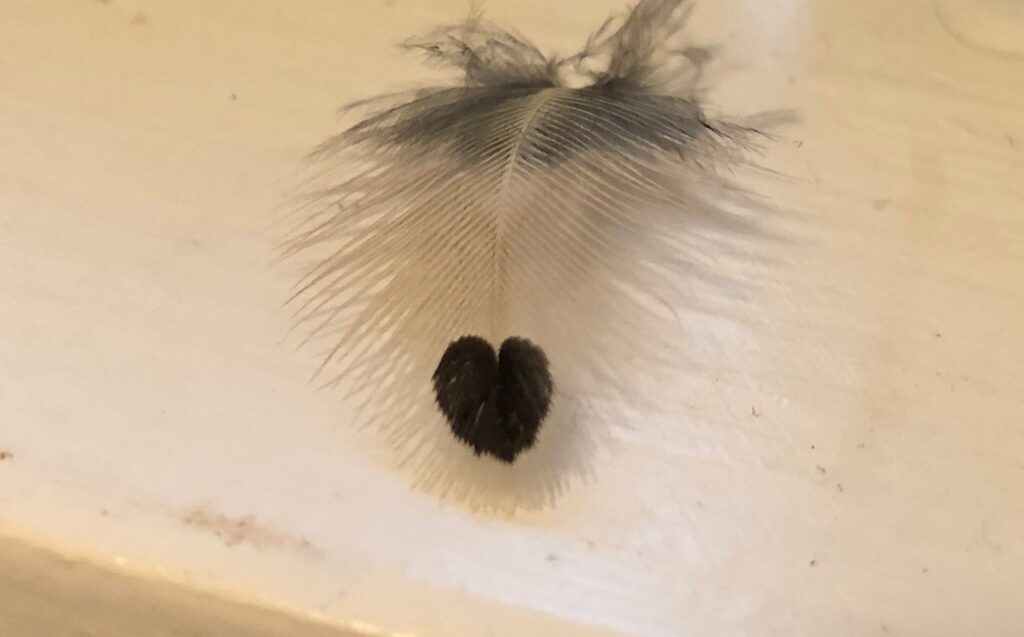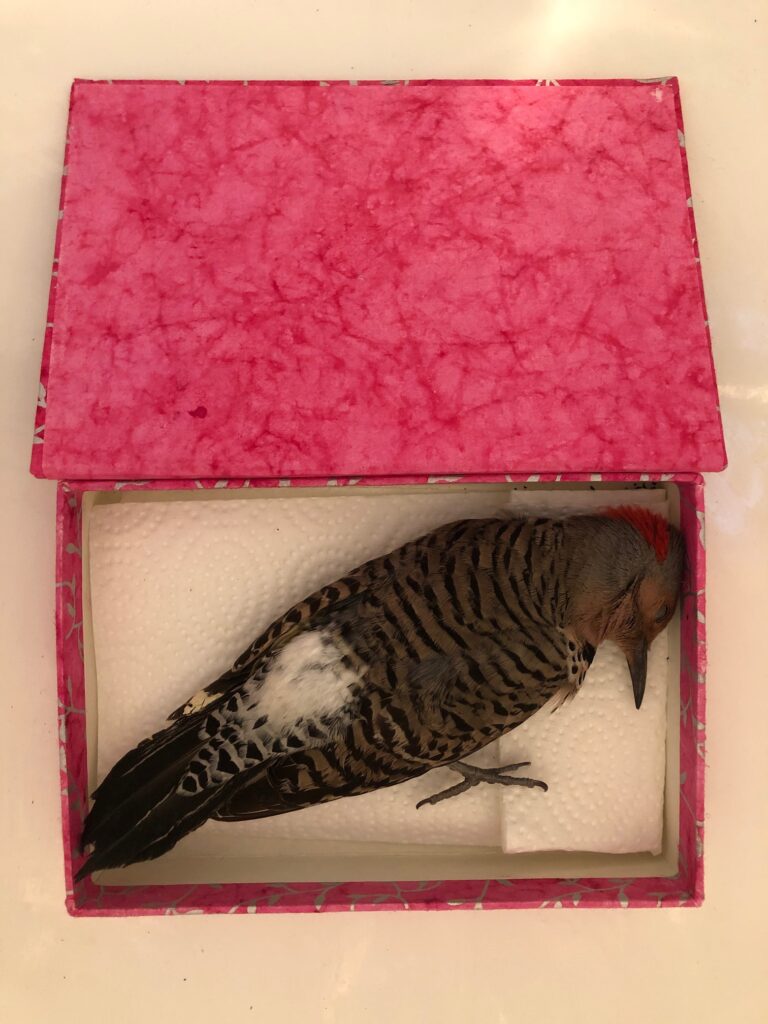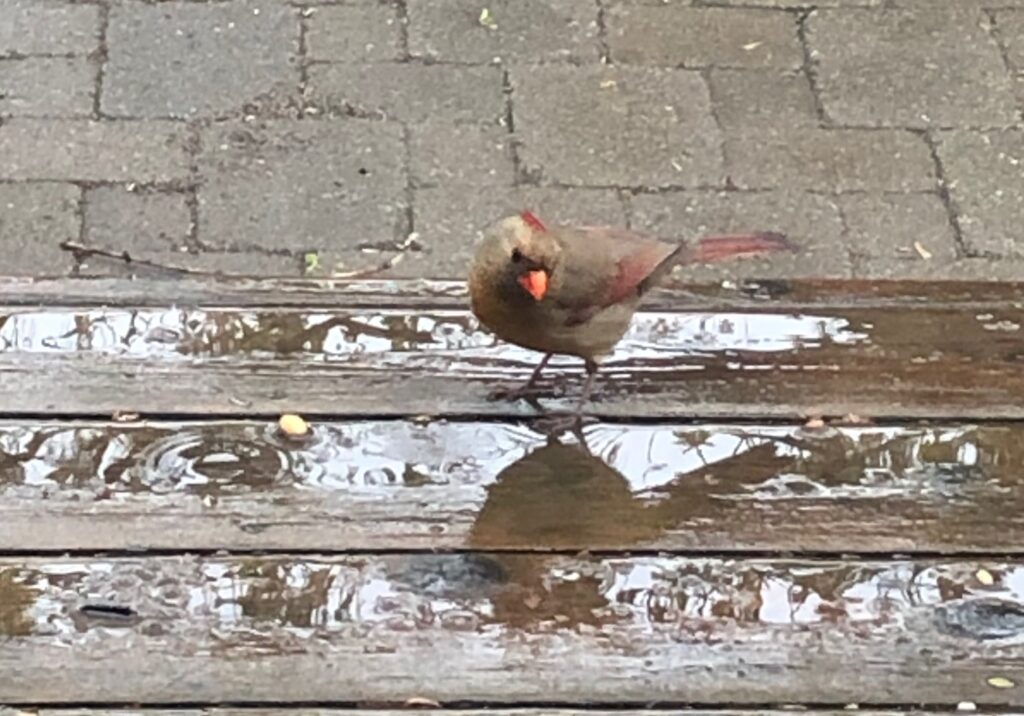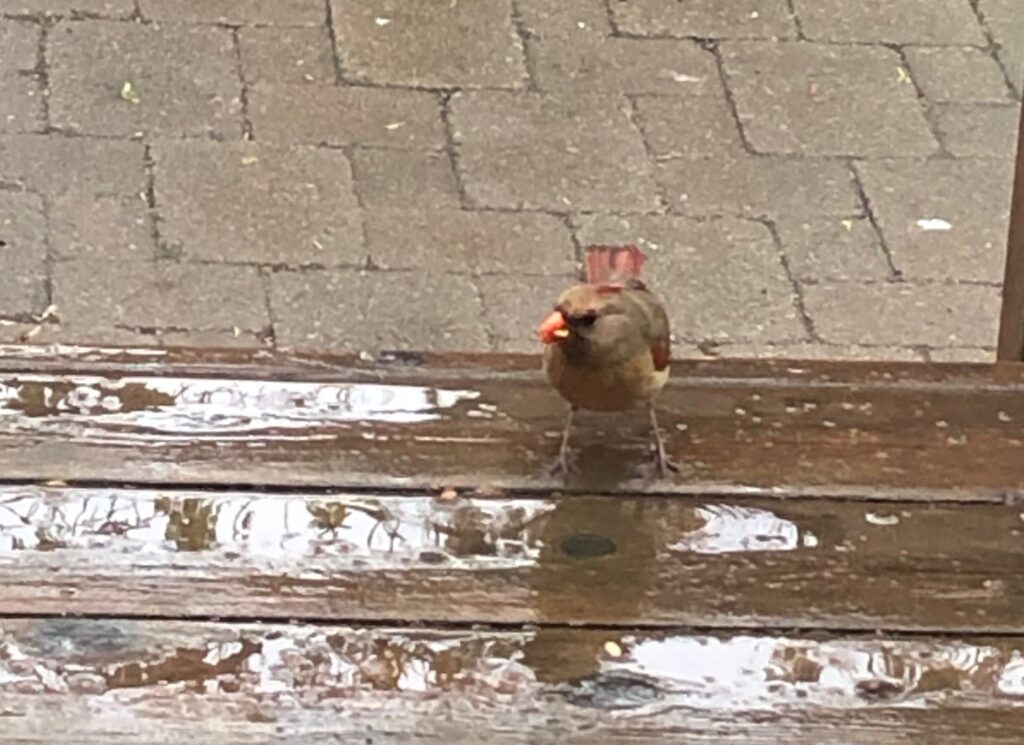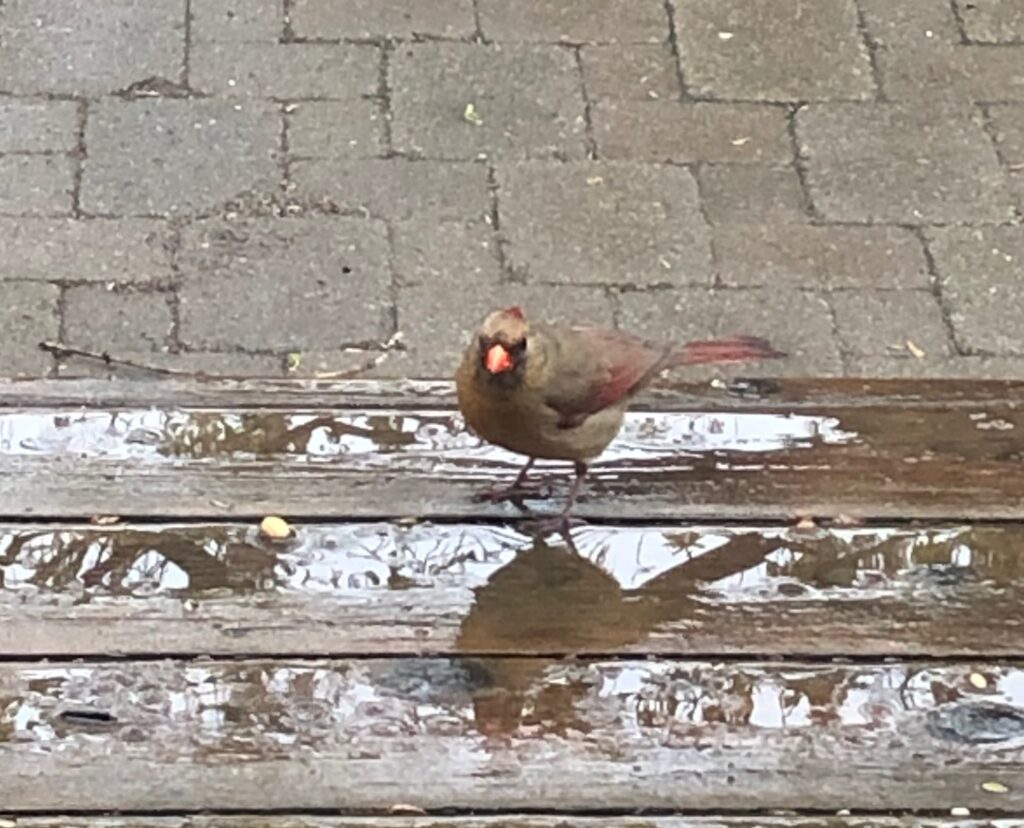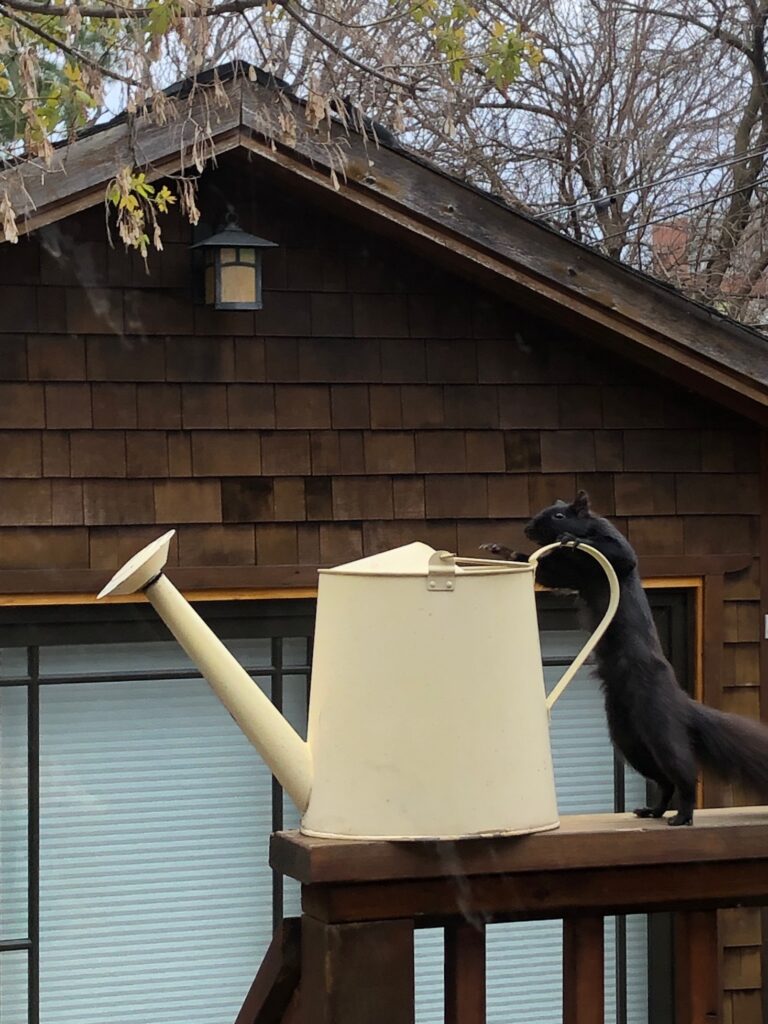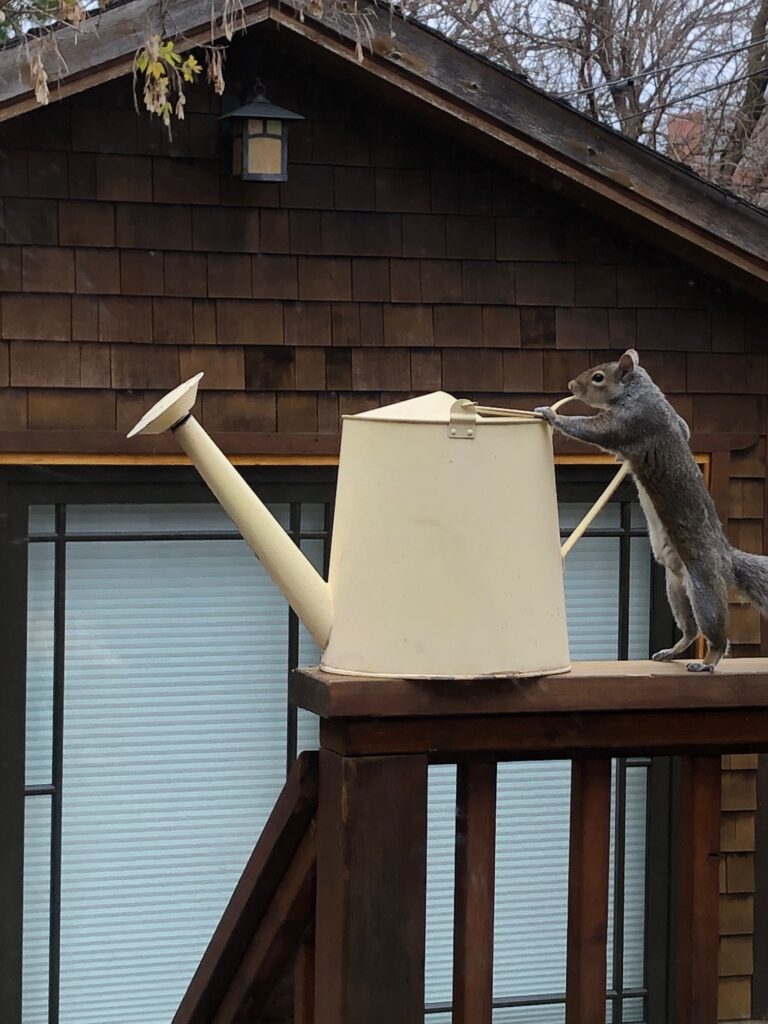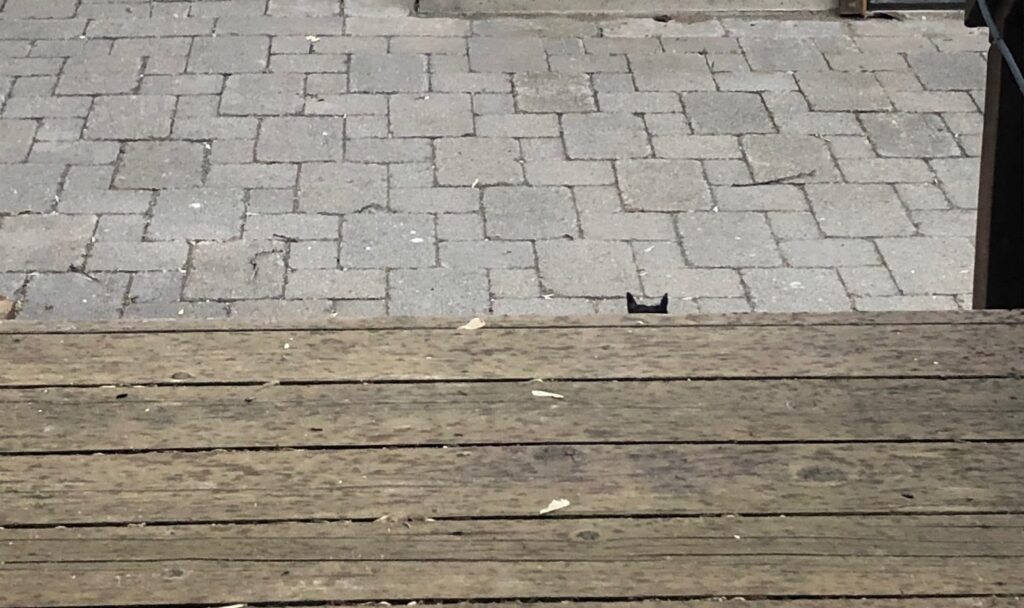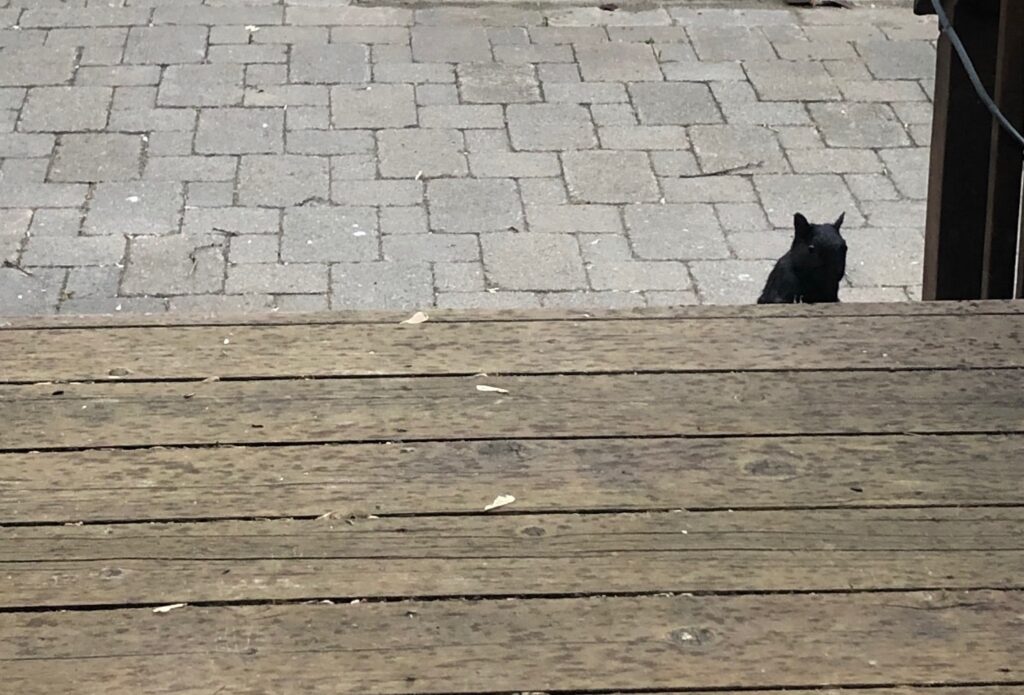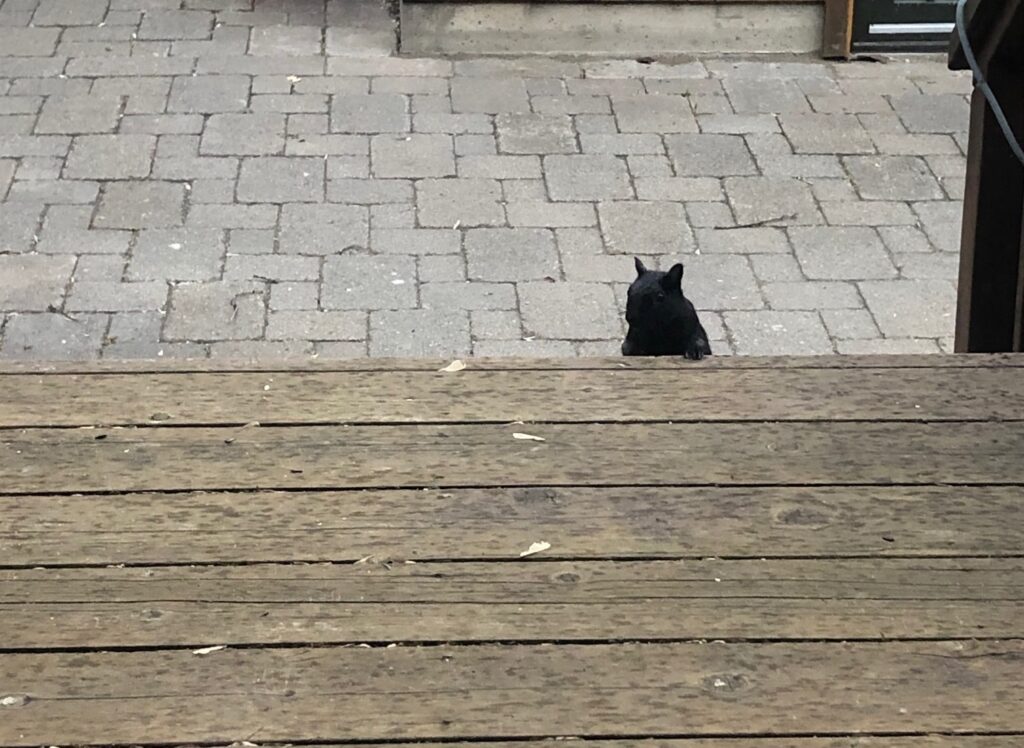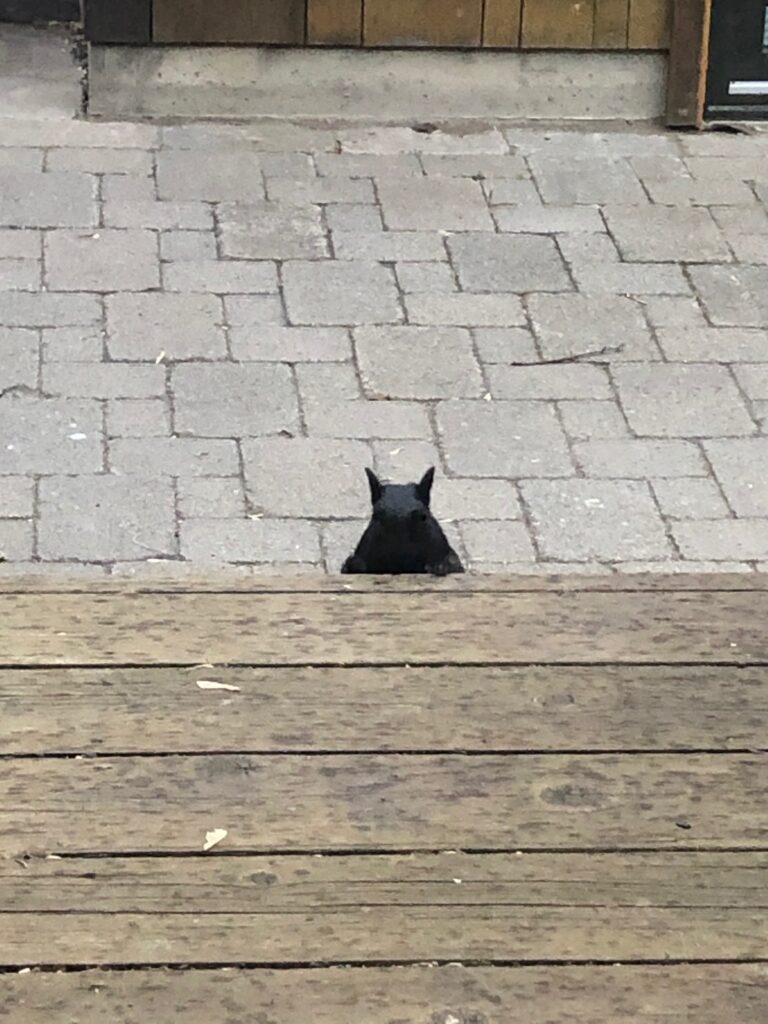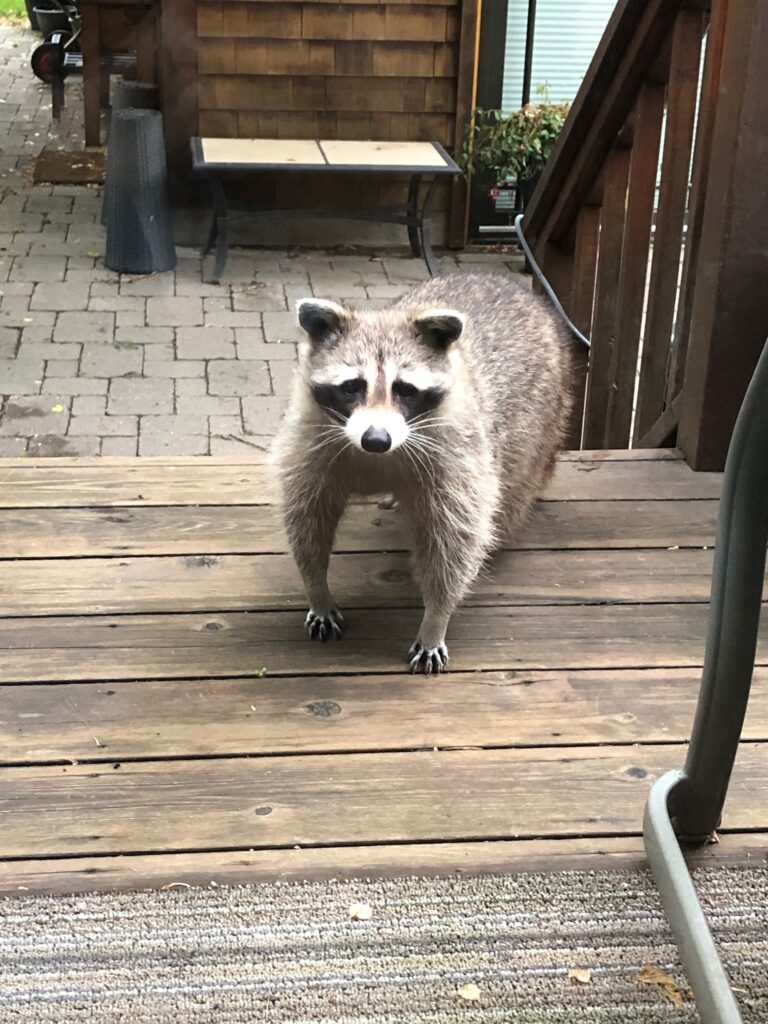
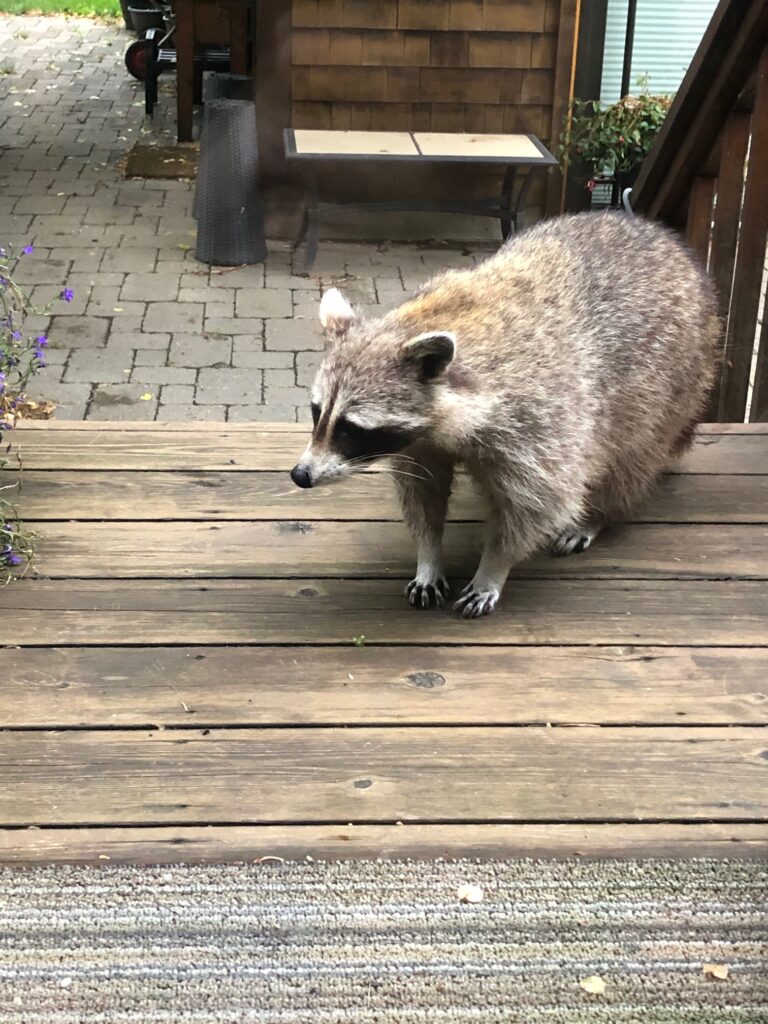
While her friend just waited ….
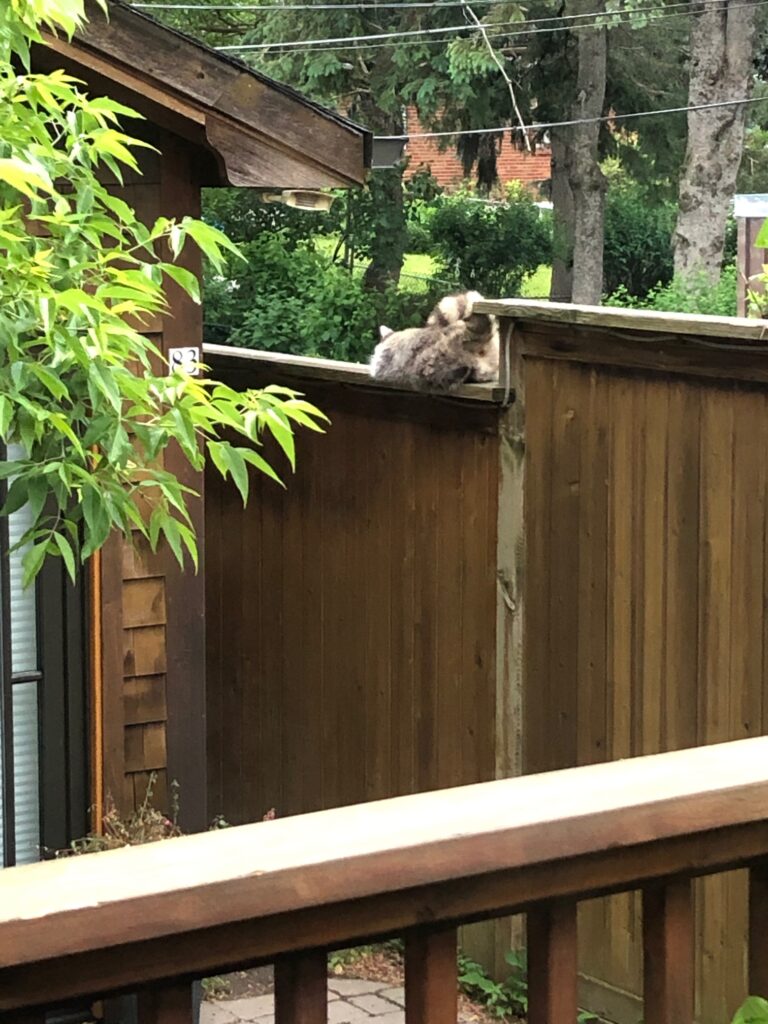
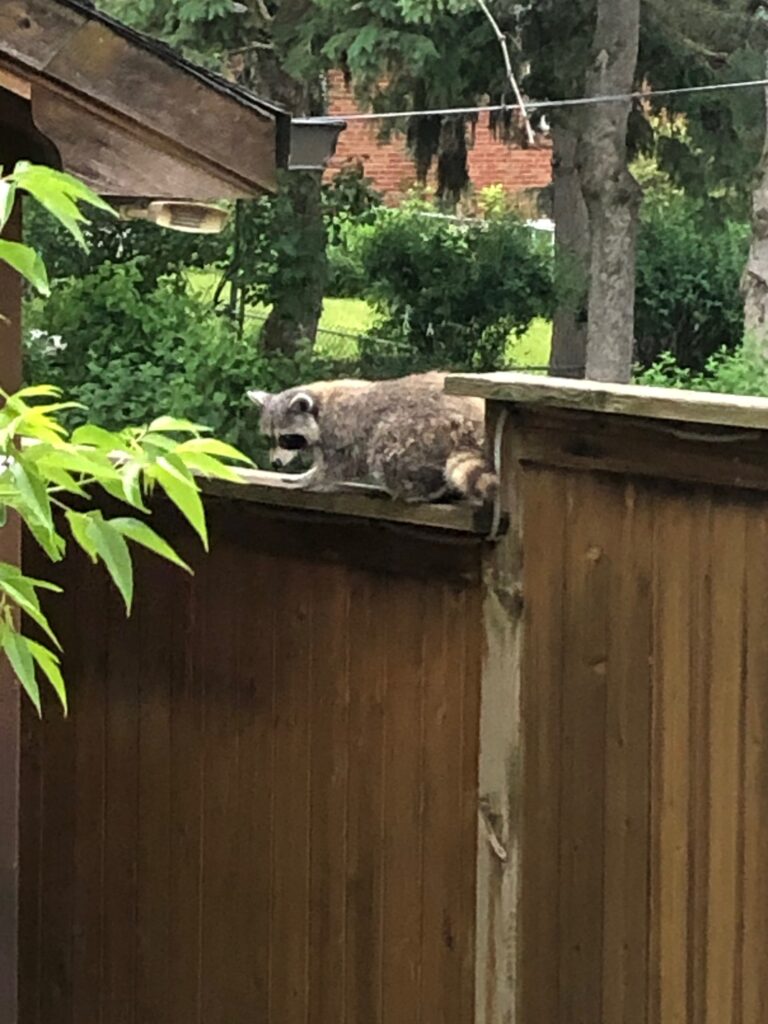


While her friend just waited ….


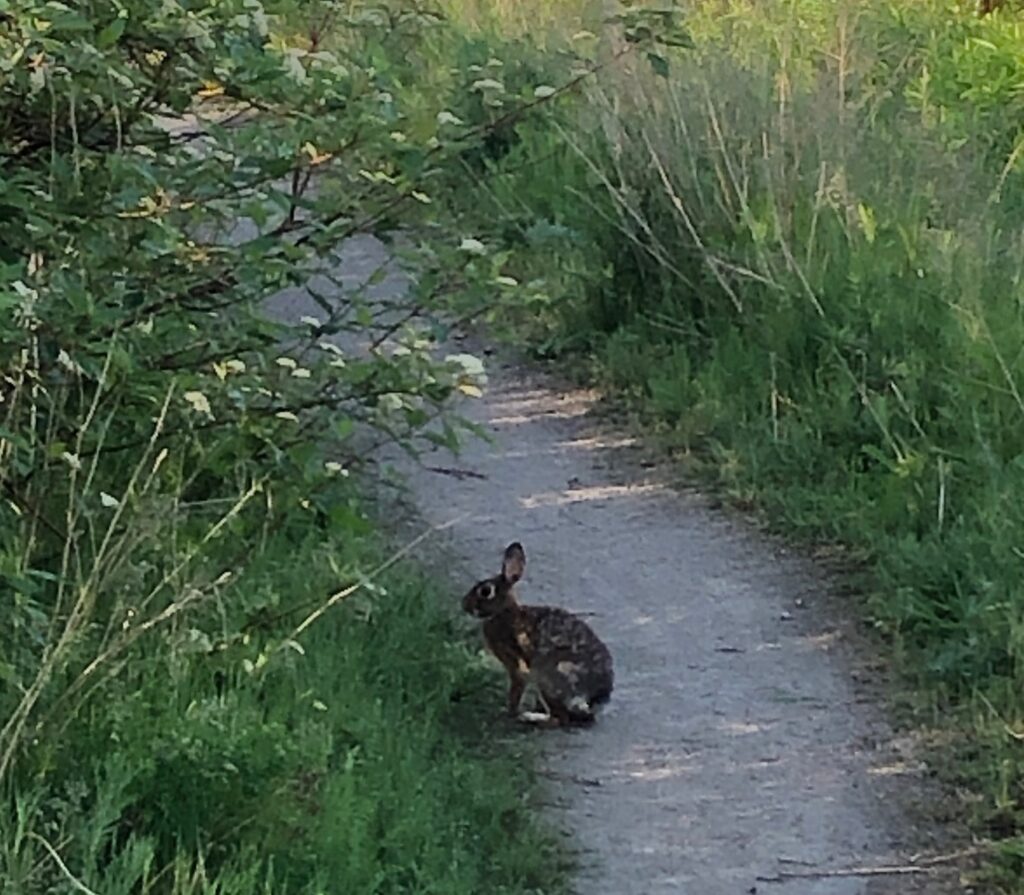
This morning I got up super early (6am was crazy early for me until a few weeks ago) and decided on the spur of the moment to go to Tommy Thompson Park for my long morning walk. I’m so glad I did!
In addition to an amazing air show and the symphony of birds — including incredible trumpeter swans flying, swooping, calling to each other and tending to babies — and a quick glimpse I got of a beaver, today it was a joy to encounter two eastern cottontail bunnies.
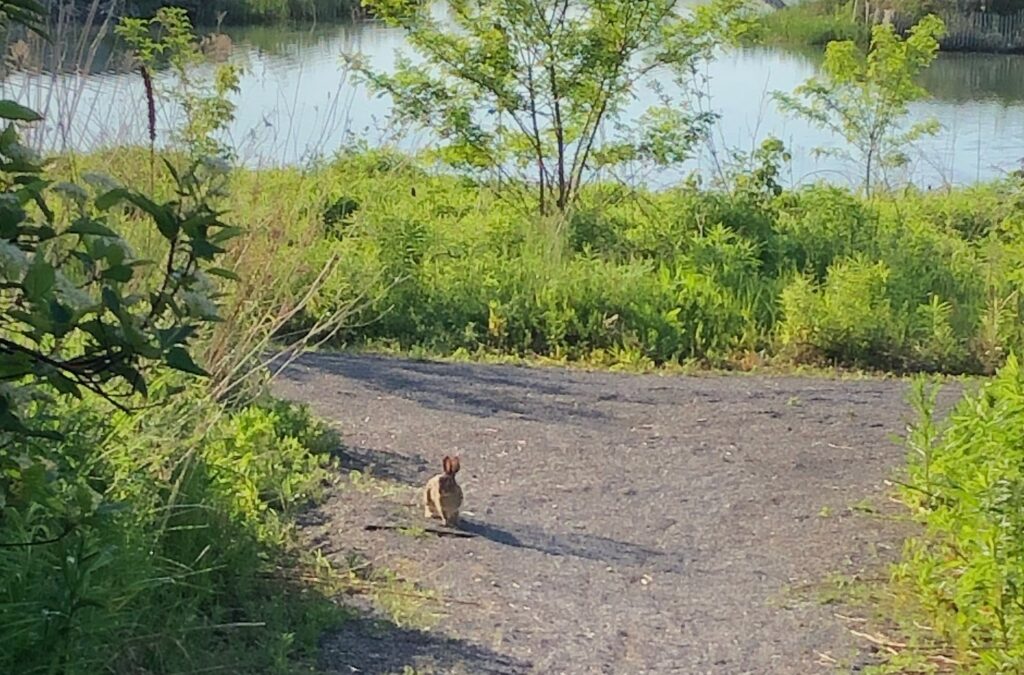
The first cottontail met me on a wide open path, watched me for a minute or two, then hopped into the brush. It was a large calm alert adult.
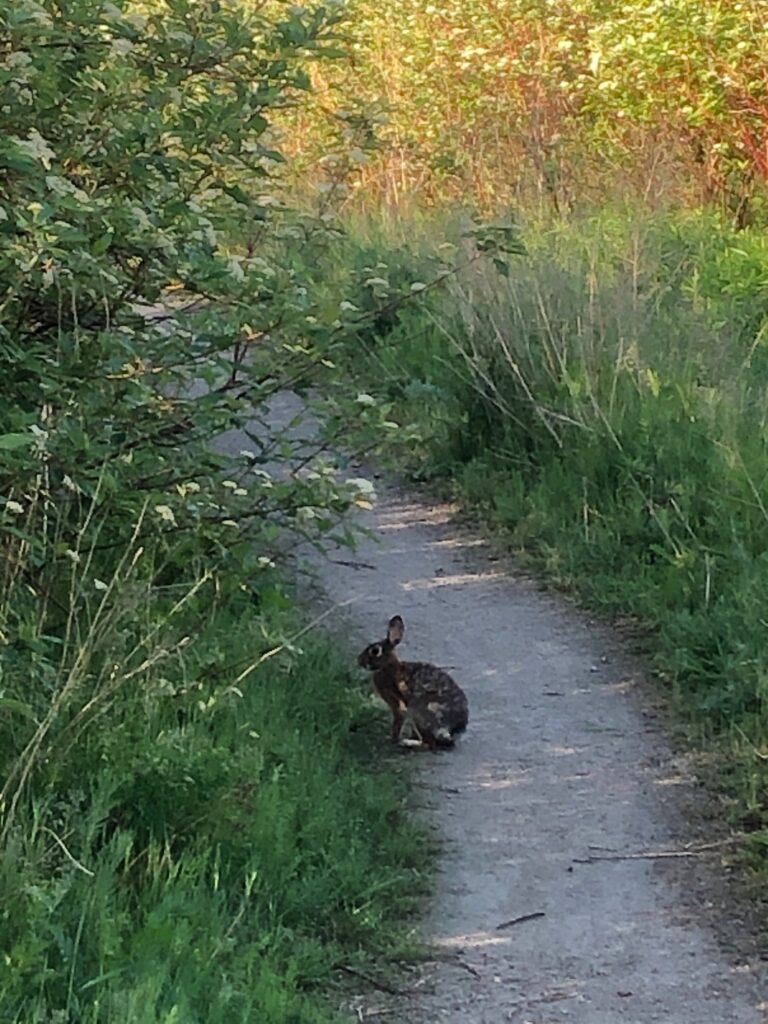
I met it again on another nearby path, where it sat and looked at me for what seemed like a very long time. In fact, it was probably only 2 or 3 full minutes. Then it seemed to be showing me the way – leading me down the path for a while. Until it lept to the right, off the path into a small meadow-like strip of land.
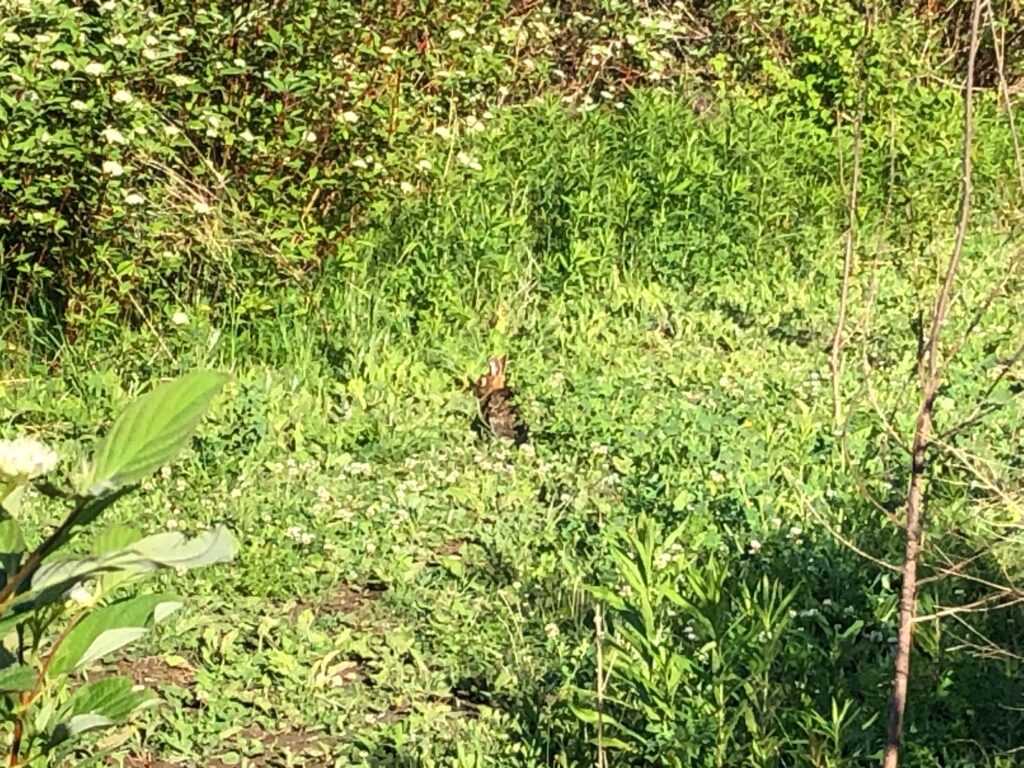
Then on my return, on a different trail on the other side of the park, I saw a young cottontail just of the path.
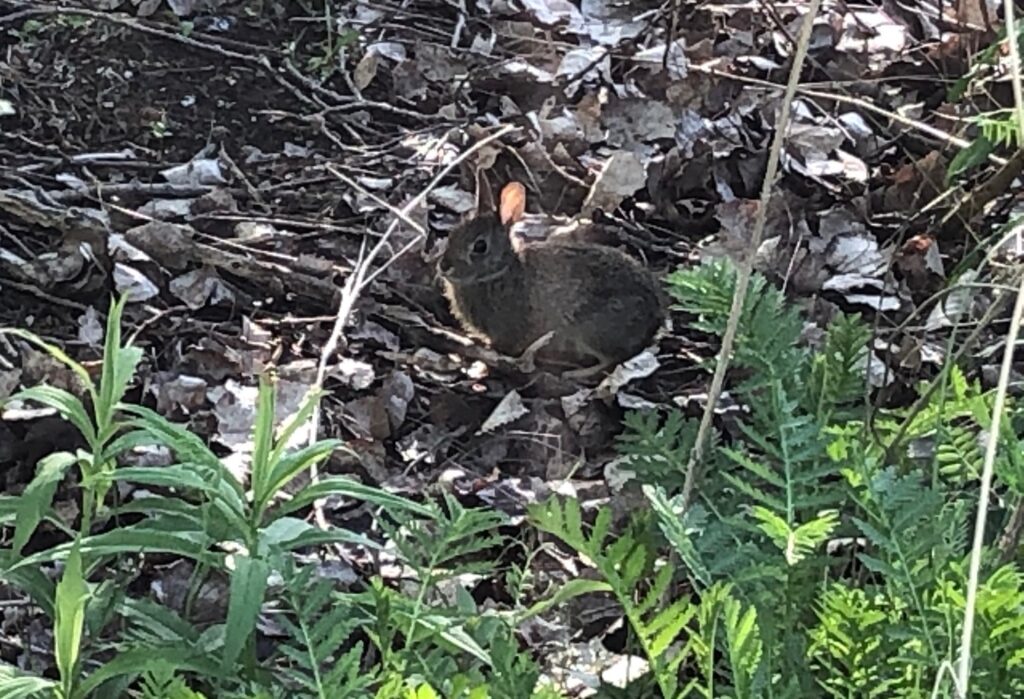
Amazing how well it was camouflaged in the leaves and against a tree.
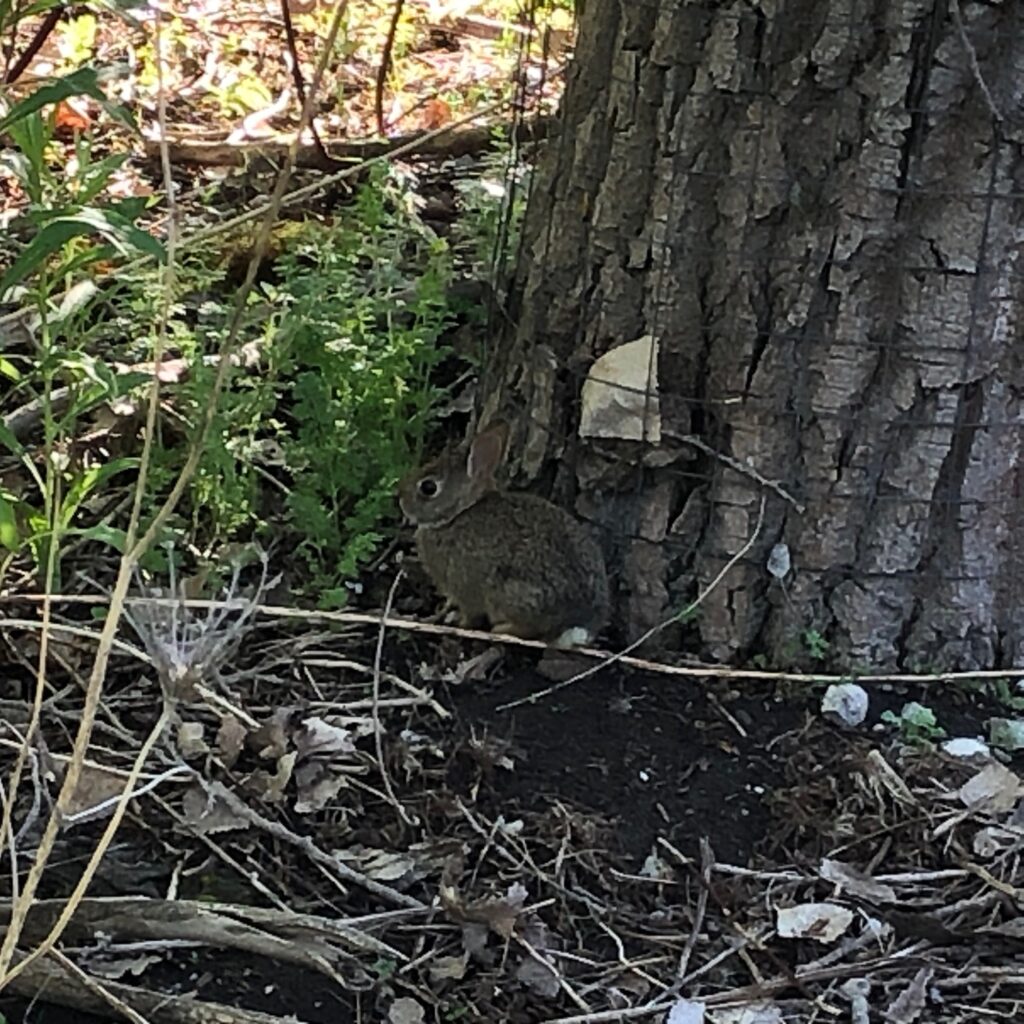
Although the two I saw today were quiet, still, and lopped a little further way from me to keep a distance within their comfort zone, eastern cottontails are actually superfast – like 40km per hour fast! Though they are usually end up running slower because they run in a zig-zag pattern. And they can leap 15 feet in one jump, if they want to. (Which, you’d imagine they need to be able to do, to outrun predators like coyotes, foxes, hawks, and others.)
I was also surprised to learn that cottontail rabbits are crepuscular (most active at dawn and dusk) and nocturnal (active mainly at night).
In some Indigenous cultures, Nanabush (or Nanabozho), the trickster, teacher, and co-creator of the world, is a raven, a coyote – and a rabbit.
Here are a few fun facts, from Wild City by Doug Bennett and Tim Tyner:
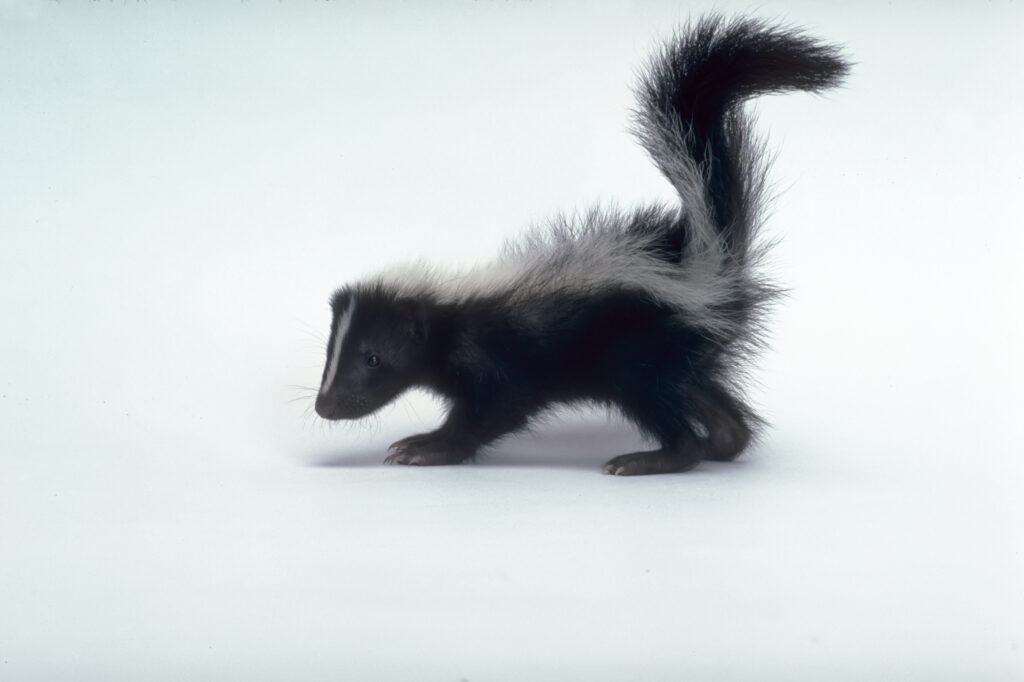
Ok, there are few things as adorable and funny as baby skunks.
They practice being scary: tails straight up, aiming their tiny pink bum, and stomping.
Stomping is a defense behaviour where skunks slap their two front paws down to scare away anything that seems threatening. The furball babies do it with a little jump! Adorable and hilarious! Could be in a Disney movie.
The trick to handling a skunk is to tuck its tail under their body so he/she can’t spray.
Of course, the trick to that is getting close enough to the skunk (without getting sprayed) to tuck the tail, ha! With the babies it is not difficult, but I would not recommend trying with an adult. Especially not an adult protecting her babies.
A skunk can spray its musk more than 10 feet with extreme accuracy. But it would rather not, since it takes skunks weeks to replenish that last-resort defense mechanism. Ideally what they perceive as a threat is scared off by the stomping and growling that babies practice.
Most skunk litters are around 5-7 kits in May, so the babies we are seeing now are approximately 2-4 weeks old.
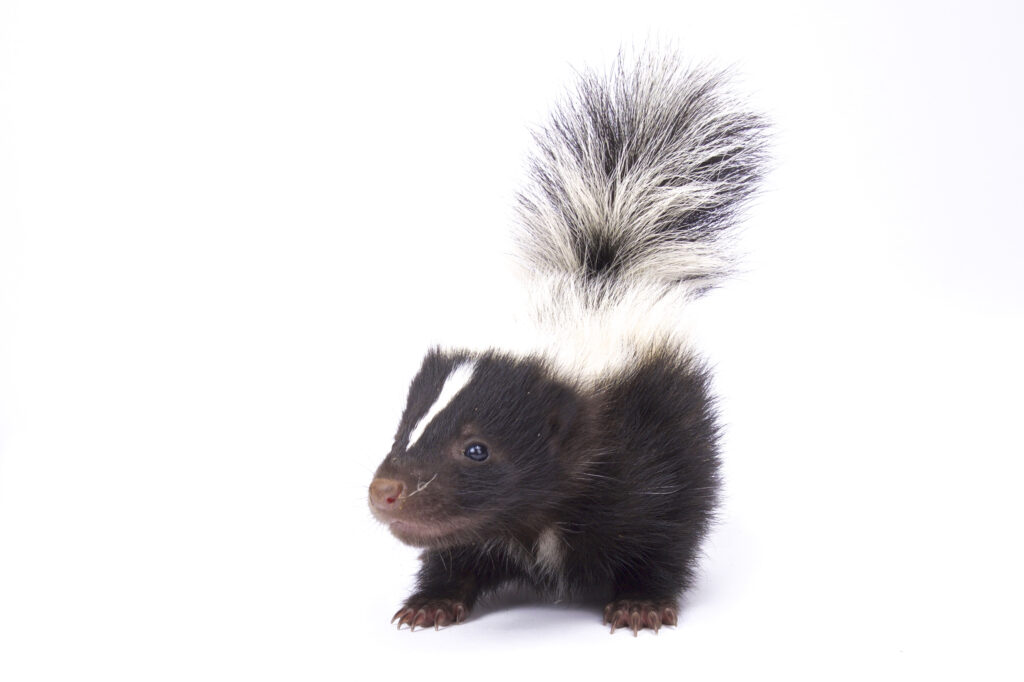
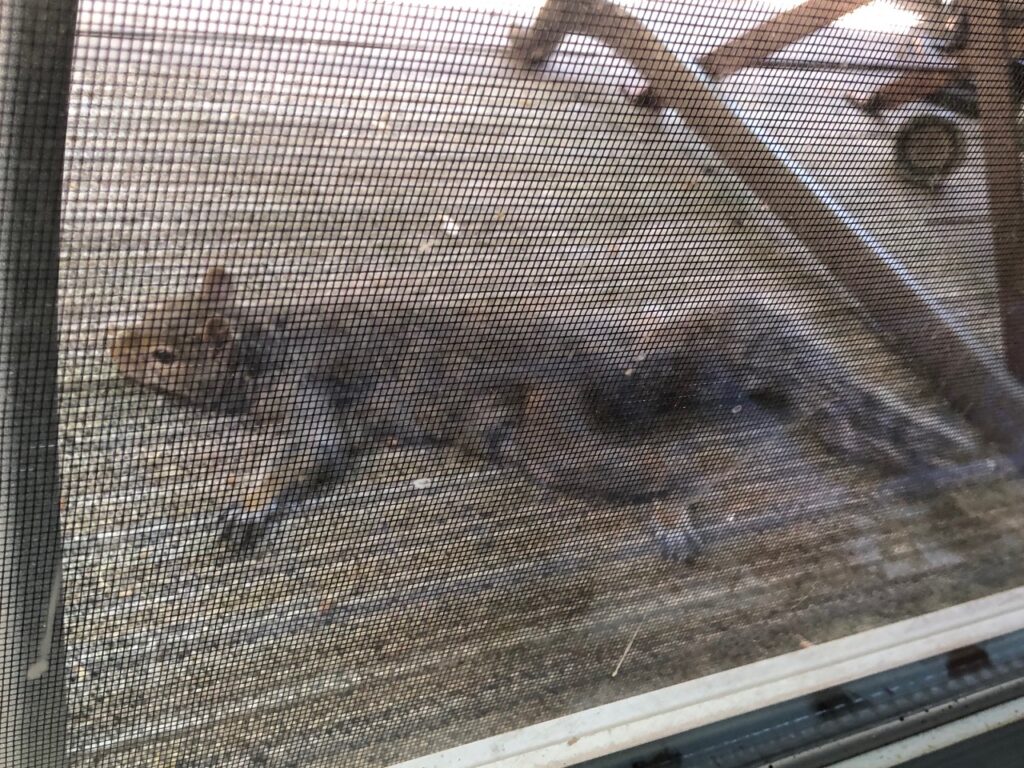
It’s somewhere around 30 degrees in Toronto this afternoon. My little friend Gradie is lying spread-eagle in the shade of a chair on my porch beside me as I work inside.
Yesterday he lay on his stomach in the shade on the driveway, all four legs straight out in each direction. And earlier today I saw another of my squirrel neighbours, Mimi, in the same position in my back yard.
Apparently, this is called “planking” or “heat dumping,” and, as you’d guess, it helps them cool down. The idea is to get as much of the surface of their tiny body against a cool surface, and this dissipates body heat.
DYK squirrels sweat through their feet?? I sure didn’t. They also pant like dogs and other animals. And they sometimes lick their fur so they can get a little cooler when it evaporates.
Squirrels can get heat stroke, like people, and it seems to happen primarily when the don’t have access to water. I have a small water dish out for my furry little neighbours.

This morning I shared this on my personal social media accounts:
Today’s small joy: hearing the chorus for the first time. They sound like wet wide rubber bands. Toads? (Anyone know?)
Before settling in for a day of work and meetings, I went for a walk in Taylor Creek Park, and I took a moment to go off the path and explore what might be just over a small hill.
It turned out to be a swampy area that was full of music! And loud!
I had never heard them before and I had no idea who was singing. Frogs? Toads?
Al Lerman, a “blues/roots musician who has been playing with sizzle and soul since the 70s” and great guy who I was on the Board of Directors of the Toronto Blues Society with years ago, responded to my post with this awesome message:
“Wood frogs or possibly green frog. You can hear both their calls here: https://www.naturewatch.ca/frogwatch/ontario”
What a fantastic resource! There are photos and recordings of all different kinds of toads and frogs.
There are so many great names of Ontario frogs and toads: Spring Peeper, Striped Chorus Frog, Boreal Chorus Frog, frogs with other animals in their names (which kind of cracks me up), like the Leopard Frog, Pickerel Frog, Blanchard’s Cricket Frog, and Mink Frog (wait, don’t mink eat frogs?), and of course the well-known Bullfrog.
Thanks to Al and the Frog Watch website, I was able to easily figure out that it was definitely a choir of Green Frogs I heard singing this morning. Certainly not toads!
Here’s the photo of a Green Frog that I took in the park after posting this story:
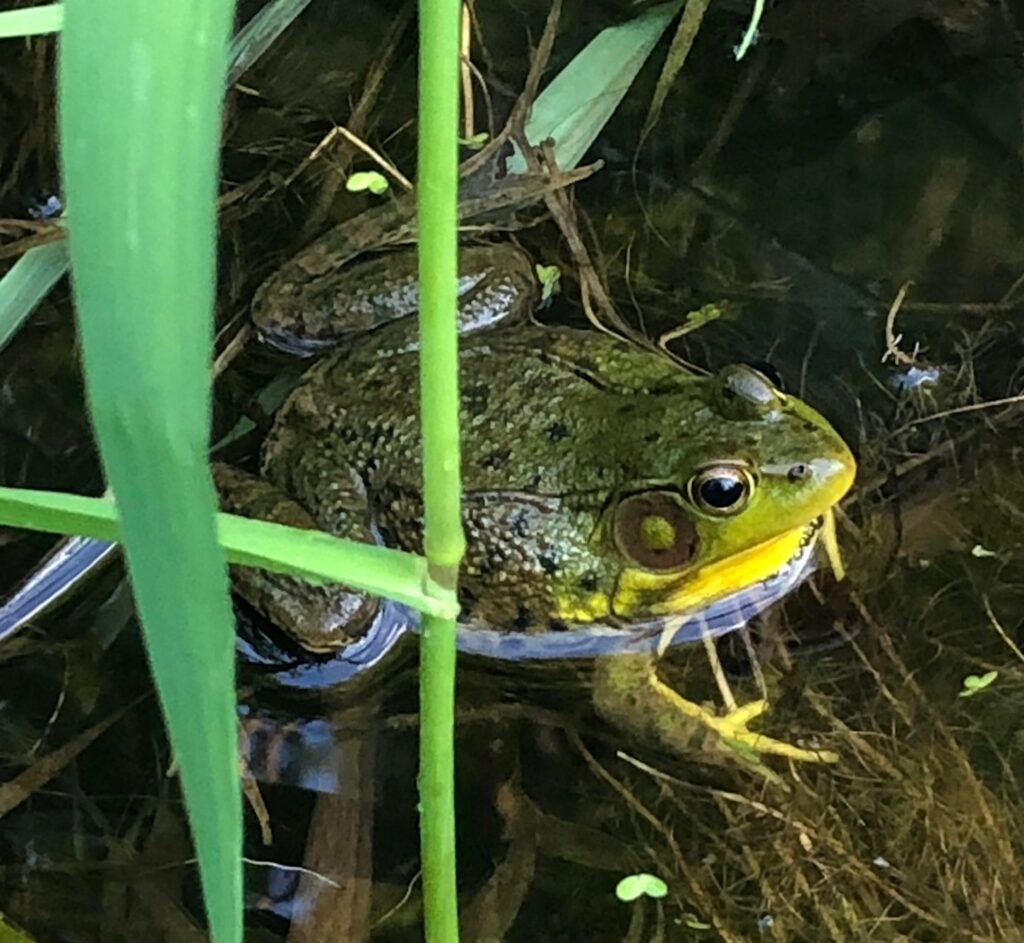
Such a cutie! 🐸
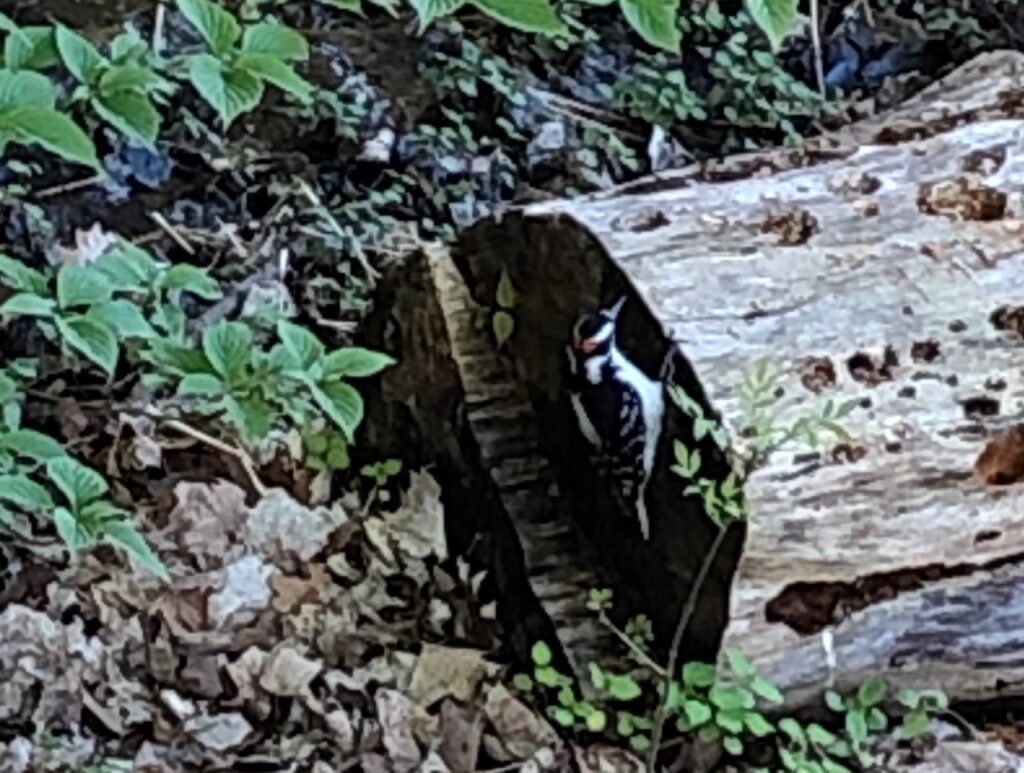
What a joy to see and hear a happy yellow bellied sapsucker at the start of my morning walk in Taylor Creek Park!
I had only seen them at the Toronto Wildlife Centre, in care with various wounds and ailments, and it was just awesome to see this beautiful one out living life in the ravine.
On a walk in the same ravine this morning – a couple of days later – I was on the same path as a woman with a dog who were stopped watching something. As I glanced over, I said, “Oh, wonderful! A yellow-bellied sapsucker!” The woman corrected me saying, “Pileated woodpecker.” I responded with “Oh? Well, it’s gorgeous!”
Hm.
So of course I had to look them up.
Here is a pileated woodpecker photo from AllAboutBirds.com:
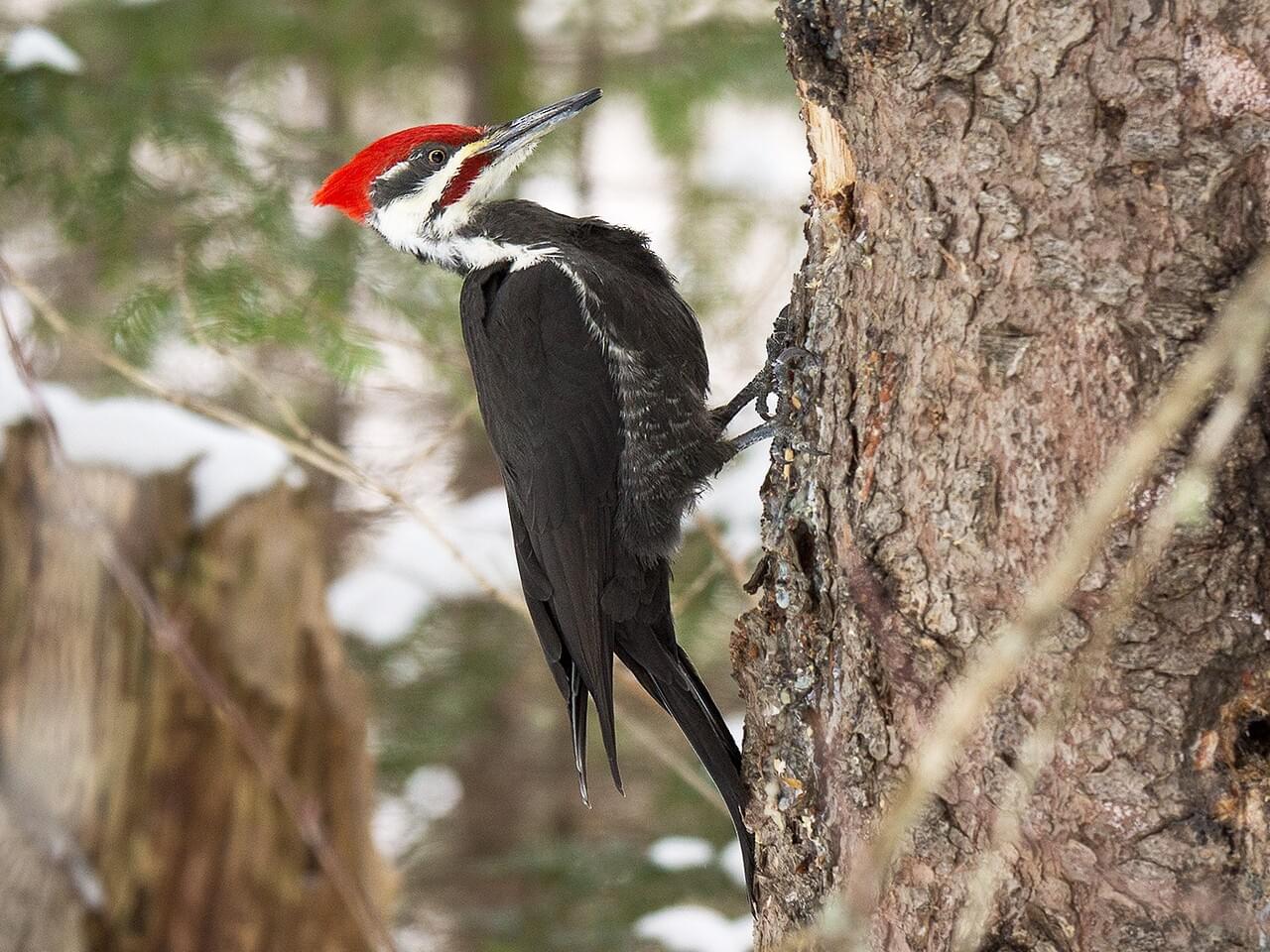
Here is a yellow bellied sapsucker photo from AllAboutBirds.com:
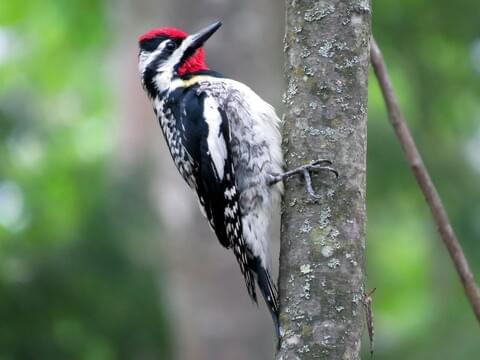
And here’s another image I took in the ravine:
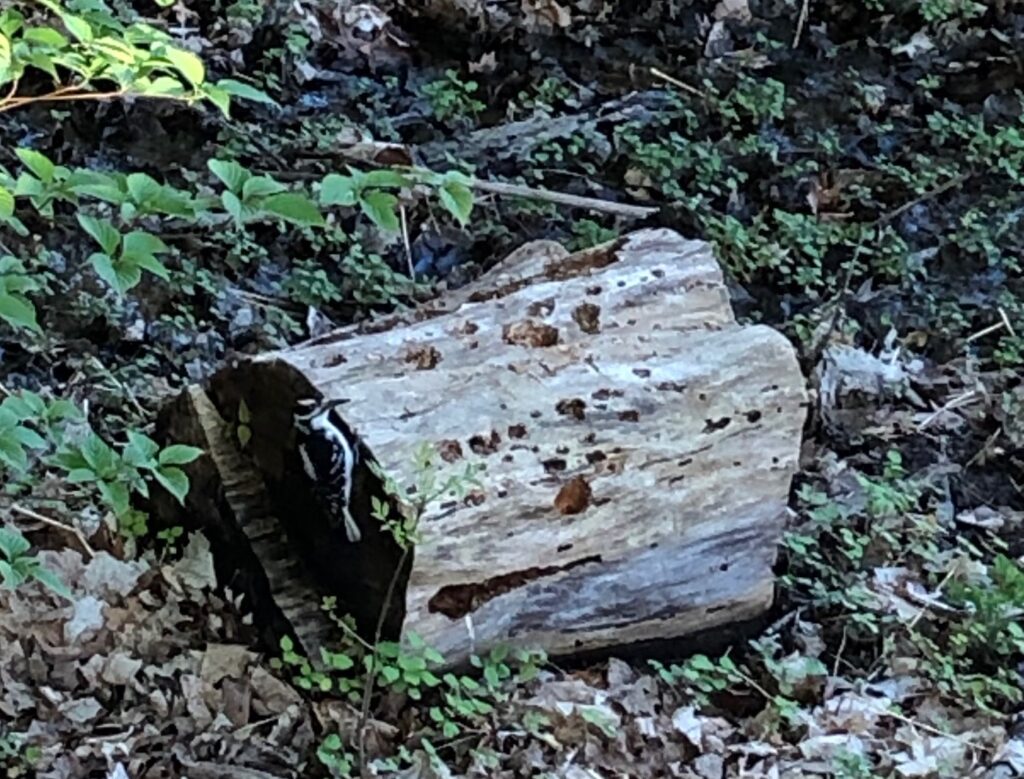
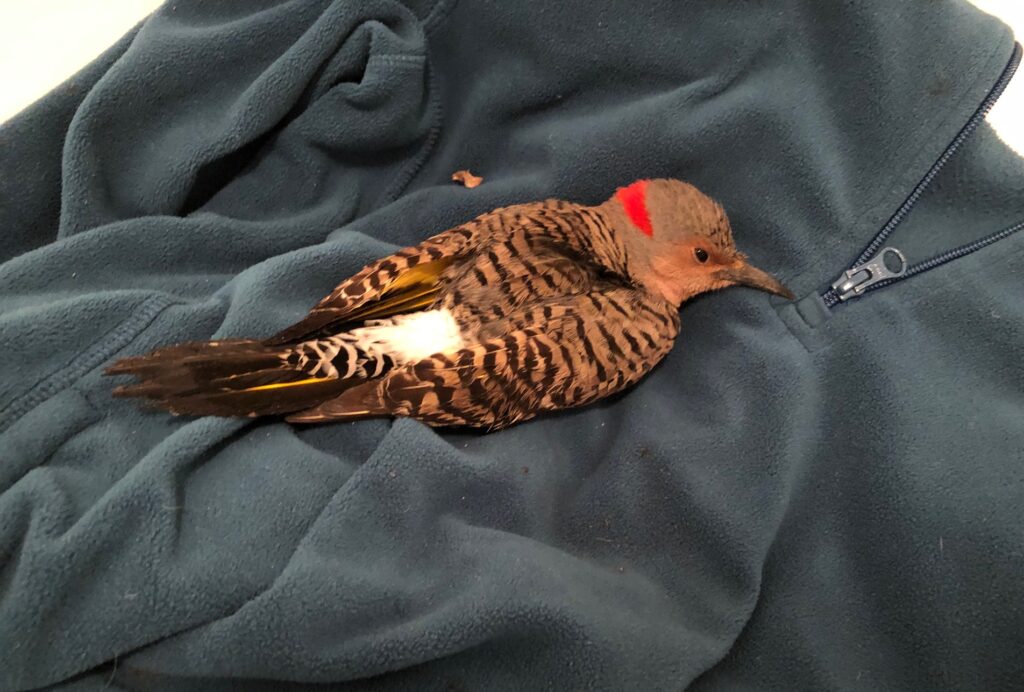
Yesterday evening around this time, I posted this to Facebook:
“Well, now I have a birdie in the bathtub. This little beauty (a Northern Flicker) was attacked by a crow in my back yard this afternoon. I couldn’t find her at the time. Then hours later I saw her. She can’t fly. As soon as she was warm, safe, and left alone in my bathtub, on my fuzzy sweatshirt, tub draped over with towels, she promptly tucked her head into her wing and fell asleep. We’ll see how she’s doing tomorrow.”
Earlier in the afternoon, I heard a squawking rukus in my back yard, and got up from my desk and went to see what the noise was about. I saw a crow see me, and fly off of a bird (I thought) it was holding. Strange, as I never see crows or any kind of corvid in our yard.
As soon as the crow flew a short distance away (I think I startled it but it would have gone back if I had not gone outside), I saw the creature hop away. I went out to investigate, but I couldn’t find it at first. The crow flew away.
Later in the evening I saw it outside the garage. It was a beautiful Northern Flicker, with gorgeous red head, yellow under her wing and tail feathers, rich brown back feathers with a clear white spot where her tail started. She was hopping around but couldn’t fly.
I captured her gently in a soft fuzzy sweatshirt and brought her inside. I set her up in the bathtub with soft sweatshirt, and a dish of water and of bird seeds. I covered the tub with towels to make it dark and quiet for her. She promptly tucked her head into her wing and fell asleep.
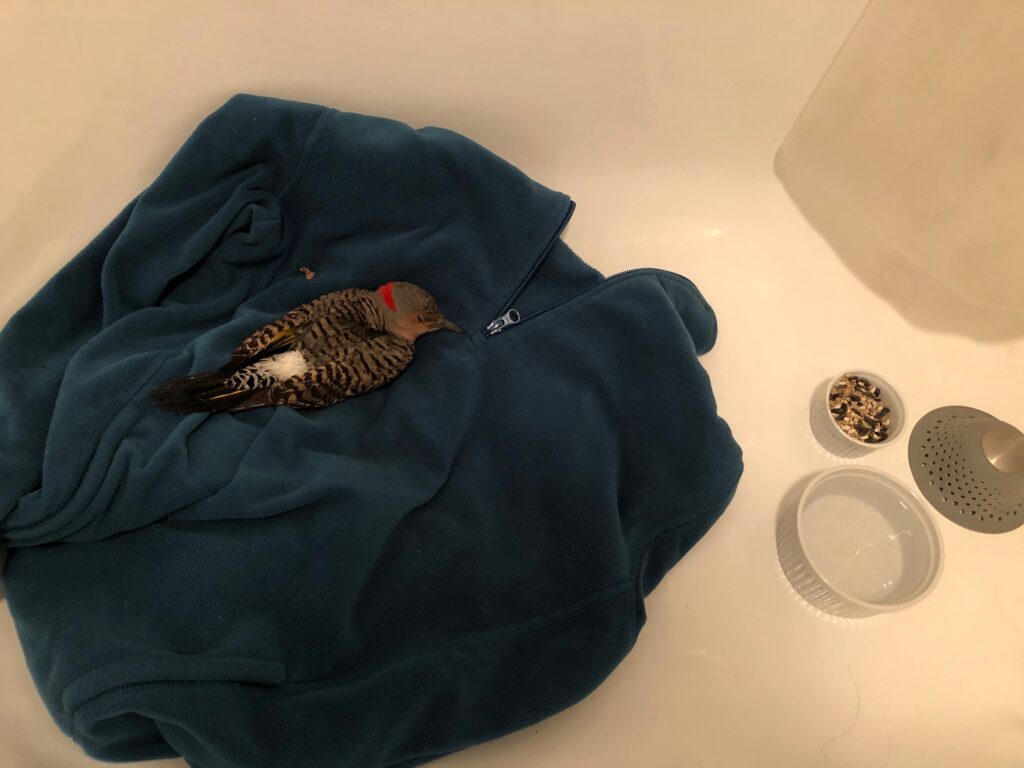
She slept for about an hour, I think. I checked on her multiple times over the next few hours, and she was awake when I went to bed at 11pm.
Sadly, she didn’t make it through the night.
It really bummed me out. I felt so badly that I couldn’t help her.
I am grateful to her for the chance to examine her beautiful little body after she died – gently and respectfully. I carefully opened each of her wings. Perfect. Nothing seemed broken. I examined her body, front and back. Softly moving aside her feathers. No wounds that I could find. I was perplexed.
What happened to this beautiful bird that killed her? Internal injuries? Extreme stress? I couldn’t find an external reason for her death. At first.
I placed her on clean paper towel in a beautiful pink cardboard box that once held small boxes of tea. It was the perfect size for her. I didn’t have the heart to dispose of her right way, so I left the box in the cleaned bathtub for the day.
Later in the evening I was able to examine her again. And I found it!
Her back was broken. I looked up bird anatomy and skeleton structure and it looks like her back was broken around the caudal vertebrae and pygostyle. That is, right at the base of the spine, where the tail attaches to the back.
I am sad she died and yet very grateful for the lesson – the teaching she gave me. I wanted to help her but I couldn’t, and in the end she gave me that gift.
